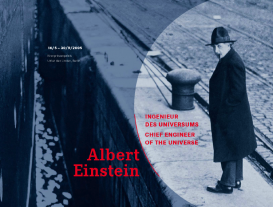A new culture of science was at the center of discussions and outreach activities during the Einstein Year 2005, a common initiative of the Federal Government, science, industry, and culture. It celebrated the centenary of Einstein's revolutionary 1905 papers. A public understanding of science in its cultural and political contexts was also the focus of the large Berlin exhibition "Albert Einstein: Chief Engineer of the Universe," as well as of the extensive accompanying program and media activities surrounding it. The exhibition was inaugurated on 12 May 2005 by Edelgard Bulmahn, then Federal Minister of Science and Education.
In 2003, a project group of department 1 began to prepare the exhibition together with other Max Planck Institutes, international partners, an international and interdisciplinary scientific advisory board, exhibition makers, and media representatives. A close cooperation with the Hebrew University of Jerusalem, the Deutsches Museum Munich, and the University of Pavia, and cooperation with the Federal Ministry for Science and Education as well as funding by the Kulturstiftung des Bundes, the Ministry, the Heinz-Nixdorf, the Robert-Bosch, and the Klaus-Tschira Foundations as well as other foundations, firms such as BASF and SIEMENS, and partners, such as DESY and CERN, laid the foundations for the success of the exhibition.
From May 16 to September 30, 2005 more than 130,000 visitors experienced the exhibition as a highlight of the Einstein Year. Staging the history of science as an adventure of discovery and struggle for knowledge, the exhibition succeeded in reaching a broad public. It was particularly acclaimed by younger visitors. More than 10,000 students and children participated in guided tours or in workshops held at the exhibition.
The goal of the exhibition was to take the life and science of Albert Einstein as a guide for illustrating the historical change of scientific worldviews and the development of science in a broadly understandable way. Einstein’ s biographical path was set in the context of the political and social cataclysms of his time. By connecting history of science and history of culture, visitors were offered a perspective on Einstein’ s biography that transcended the traditional image of an ingenious and exceptional scientist. Scientific knowledge was not offered as a collection of rigid facts but as part of a dynamical, multi-facetted cultural process. Indeed, it was not the exhibition's primary aim to provide fixed answers, but rather to encourage the visitors to question and interact with the contents of the exhibition. The representation of historical worldviews and the reference to present challenges of the sciences animated the visitors to develop their curiosity, to discover the cultural dimension of scientific knowledge, and to address questions about the social and political significance of scientific research.
The catalogue of the exhibition actually represents a compendium of the history of science that focuses on changes in scientific worldviews as they were characteristic of Einstein's revolution. It consists of three volumes: The first volume closely follows the narrative structure of the exhibition; the second volume assembles more than 100 essays on the historical background of Einstein's life and work as well as on related issues of current research; the third volume offers a comprehensive documentation of original sources reproduced as high-quality facsimiles, setting Einstein’ s biography in the context of his times. In addition, a DVD with video and audio material from the exhibition was published, serving as a complementary resource to the virtual exhibition and as a tool for science education and popularization.
The Einstein exhibition was accompanied by a program of scholarly and public events which connected its themes with the wider discourse on science and its contexts in the Einstein Year. For the Institute, this accompanying program was an opportunity to present the results of its research projects in a new ways and to extend its network of collaborations including media partnerships with TV and radio channels, newspapers, journals, and magazines. The program addressed a broad variety of age and interest groups and comprised public lectures, theatre plays, cinematographic events, round-table discussions, TV and radio events, newspaper and journal contributions, summer camps for students, international school conferences with students from Poland, Switzerland, Italy, and Germany, children's events, etc. One of the highlights of the accompanying program was an interdisciplinary lecture series, entitled "Einstein Lectures," co-organized with the three Berlin Universities and the Young Academy of Sciences in Berlin, and attended by more than 2,500 participants.
The Einstein exhibition was fully documented by a photographic campaign, and is—including all information, that was presented in the real exhibition on ca. 50 media stations—now publicly available (>> Virtual Einstein Exhibition)

